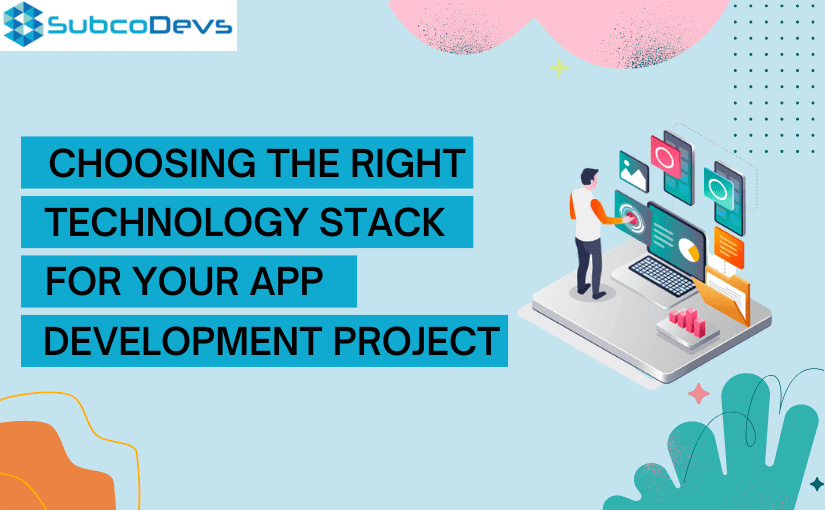In the fast-paced world of app development, making the right technology choices can significantly impact the success of your project. The technology stack you choose plays a crucial role in determining the app’s performance, scalability, security, and overall development efficiency. Selecting the appropriate technology stack can be a daunting task, especially with the plethora of options available.
In this blog, we will explore the essential considerations and steps to help you make an informed decision when choosing the right technology stack for your app development project.
Understanding the Technology Stack
A technology stack, often referred to as a tech stack, is a combination of programming languages, frameworks, libraries, and tools used to build an application. It comprises both the front-end and back-end components, as well as any other necessary infrastructure elements. The technology stack forms the foundation of your app and influences its architecture, functionality, and performance.
Assessing Project Requirements
The first step in choosing the right technology stack is to thoroughly assess your project’s requirements. Take into account the following aspects:
- App Type: Determine whether your app will be a web application, mobile app (iOS, Android, or cross-platform), or a desktop application. Different platforms may require different technology stacks.
- Functionalities: List down the key functionalities and features your app will offer. This will help you identify the technologies best suited to fulfill these requirements.
- Scalability: Consider the expected user base and data load. Your technology stack should be scalable to handle increased traffic and growth over time.
- Performance: Evaluate the performance demands of your app. Certain technologies may provide better performance for specific use cases.
- Security: App security is paramount. Ensure that the technology stack you choose supports robust security measures to protect user data and prevent potential vulnerabilities.
- Budget and Time Constraints: Determine the budget and timeline for your app development project. Some technologies may require more resources and time for implementation.
-
Front-End Technology Stack
The front-end technology stack governs the user interface (UI) and user experience (UX) of your app. Key components of the front-end stack include:
- HTML/CSS: HTML (Hypertext Markup Language) provides the structure of your app, while CSS (Cascading Style Sheets) handles the visual layout and design.
- JavaScript Frameworks: Popular JavaScript frameworks like React, Angular, or Vue.js enable dynamic and interactive front-end development.
- Responsive Design: Ensure your app is responsive and mobile-friendly to provide a seamless experience across different devices.
- User Experience (UX) Libraries: Utilize libraries like Bootstrap or Material-UI to enhance the app’s UX and speed up development.
-
Back-End Technology Stack
The back-end technology stack manages the server-side logic and database operations. Key components of the back-end stack include:
- Programming Language: Choose a programming language that aligns with your project’s requirements. Common options include Python, Ruby, Java, Node.js, and PHP.
- Web Framework: Select a web framework that complements the chosen programming language and simplifies development tasks. Examples include Django (Python), Ruby on Rails (Ruby), Spring (Java), Express (Node.js), and Laravel (PHP).
- Database Management System: Opt for a database system that best suits your app’s data requirements. Popular choices include MySQL, PostgreSQL, MongoDB, and Firebase.
- Server Hosting: Consider the hosting options, such as cloud services like AWS, Google Cloud Platform, or Microsoft Azure, or traditional web hosting.
-
Integrations and APIs
Depending on your app’s functionalities, you may need to integrate with third-party services or create your own APIs. Verify that your chosen technology stack supports easy integration and API development.
-
Community Support and Documentation
A vibrant developer community and comprehensive documentation are crucial factors in easing the development process. Opt for technologies that have active communities and abundant learning resources.
-
Security and Scalability
Ensure that the technology stack you choose provides robust security features and allows easy scalability to handle increased user demands.
-
Team Expertise
Consider the expertise and skills of your development team. Choose technologies that align with their knowledge and experience to ensure a smoother development process.
Choosing the right technology stack for your app development project is a critical decision that can significantly impact your app’s success. By carefully assessing your project requirements, understanding the various components of the front-end and back-end stacks, considering integrations, and evaluating security and scalability, you can make an informed choice.
Remember that technology trends evolve rapidly, so it is essential to stay updated and adapt your stack accordingly. A well-chosen technology stack will pave the way for a robust, scalable, and user-friendly app, contributing to your project’s overall success. Invest time and effort in making the right decisions now, and your app will reap the benefits for years to come.
Ready to bring your app idea to life? Our expert team of app developers is here to turn your vision into reality. Whether it’s a mobile app, web app, or cross-platform solution, we’ve got you covered. Don’t miss out on the opportunity to create a cutting-edge app that captivates your audience. Get in touch with us today and let’s start building something amazing together.
